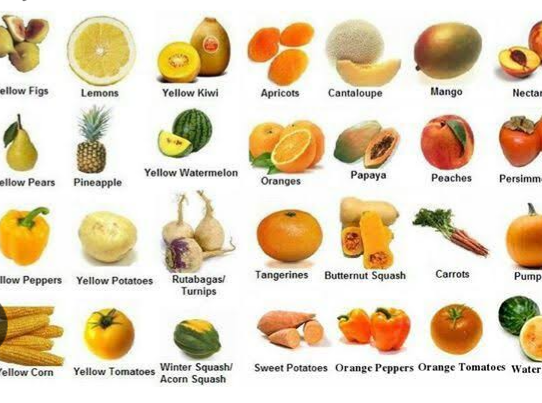
Fruits are very important in human diet. They are part of the plant which develop from the flower. They are the fleshy or dry ripened ovary of a flowering plant, enclosing the seed or seeds. When fertilisation takes place in a flowering plant, the Ovary develops to form the fruit while the ovules in the ovary develop to form the fruit seeds. When a fruit develops without fertilisation taken place in the flower, this is called parthenocarpy. For example, in bananas. Fruits from different plant have different structure, shape, sizes, taste, and nutrition,. Some fruits are round in shape, some are oval, kidney shape, oblong, wrinkle etc in shape. Some taste sweet, some sour and some bitter. etc. The principal function of the fruit is the protection and dissemination of the seed. Fruits are good sources of dietary fibre, vitamins (especially vitamin C), minerals, (especially electrolytes) and more recently phytochemicals, especially antioxidants and water.
The science of fruit production is called POMOLOGY.
TYPES OF FRUITS
Some of the types of fruits are:
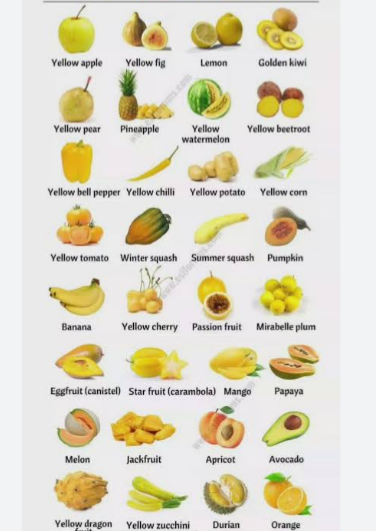
SIMPLE FRUITS: These fruits develop from the ripening of a single ovary of a flower. They are formed from one carpel (monocarpous) or fused carpel (syncarpous). Simple fruits are of two types, dry and fleshy. Dry simple fruits can be dehiscent or indehiscent. Brazil nuts, strawberries, Cashew nut, coconut, walnuts, hazelnuts, etc., are some dry simple fruits. Fleshy simple fruits are those that have a partial or full fleshy pericarp (fruit wall) on maturity. Some examples include cherry, tomato, olives, peach, plums, and cranberry.
AGGREGATE FRUIT OR ETAERIO FRUIT : These fruits develop from multiple ovaries or carpels (apocarpous) of a single flower. There are four main types of aggregate fruits, including follicles, achenes, drupelets, and berries. Raspberry, blackberry, and custard apple are some examples. Their fleshy part is derived not from the plant’s ovaries but from the receptacle that holds the ovaries. Numerous dry achenes are attached to the outside of the fruit-flesh; they appear to be seeds but each is actually an ovary of a flower, with a seed inside.
MULTIPLE FRUIT : Multiple fruits originate from an inflorescence, which means a cluster of flowers that fuses after fertilisation. Each of these flowers individually produces a fruit and the fruits, on maturity, all merge into one mass of single fruit. Pineapple, figs, mulberry, and breadfruit etc., are some multiple fruits.
BERRIES : Berry is a type of simple fleshy fruit that develops from a single ovary of a single flower. The ovary may be compound, with several carpel (that is, from the simple or compound ovary). Orange, guava, tomatoes, Cranberry, grapes, currants, cucumbers, eggplants (aubergines), tomatoes, chili peppers ,and blueberry are the most common examples of berries.
True berry excludes certain fruits that are called “berry” such as strawberries and raspberries.
ACCESSORY FRUIT : Any fruit whose edible part comes from the other floral parts of the flower, like the receptacle, hypanthium, petals, or seals besides the ovary, is an accessory fruit. It can be simple, multiple, or an aggregate fruit. Most common examples include pineapple, apple, stone fruit, and strawberry. The pineapple is a multiple-accessory fruit, blackberry is an aggregate-accessory fruit, and apple is a simple-accessory fruit
SEEDLESS FRUIT : Seedless fruits mature in two ways. The first is where the fruit develops without parthenocarpy, whereas the second is where pollination stimulates fruit development. These are the most valuable fruits as they are consumed by a majority of people.
IMPORTANCE OF FRUITS
1. Antioxidants in fruits helps in cleaning up free radicals that causes detrimental health effects
2. Fruits are sources of fibers which prevent constipation and help ease the bowel.
3. Some fruits contain high amount of anthocyanins, flavonols and procyanidins, which are effective at decreasing cardiovascular risk
4. Some fruits contain carotenoid which when consumed help maintain the cholesterol level in blood
5. Fruits are rich sources of calcium and other vitamins which are vital in bone health( that is, help prevent osteoporosis in adults)
6. Some fruits contain phytoingredients which help in protecting lens damage which occurs due to hyperglycemia and certain flavonoids such as quercetin can prevent oxidative stress in the pathogenesis of glaucoma.
7. Phytochemicals in fruits have been found to act as anti-obesity agents because they help in suppressing growth of adipose tissues
8. Increased consumption of fruits help to ease weight loss when they are used to displace high-energy-dense foods such as saturated fats and sugar.
TYPES OF NURSERIES USED IN RAISING FRUITS
1. PEASANT NURSERY: It is used by peasant farmers to raise fruit tree seedlings. Farmers do establish this nursery along river or stream banks. Cost of setting it up is low.
2. INTERMEDIATE OR TEMPORARY NURSERY: This is an improvement over the peasant nursery. It is not permanently established. It is usually located close to the anting site. The main advantage of this nursery over peasant nursery is that the long distance of transportation is eliminated
3. STANDARD NURSERY: It is expensive to establish. It is good for production of better seedlings because there is better control and good management practices and well laid out farm.
PROPAGATION OF FRUIT TREES
Fruit trees can be propagated sexually and Asexually.
SEXUAL PROPAGATION OF FRUITS
Fruit tress produce flowers which has the male and the female reproductive organs called stamen and pistil respectively. The stamen produces the pollen grain which is transfered to the pistil where fertilisation takes place. The process by which pollen grain is transfered to the pistil is called POLLINATION. Fertilisation takes place when the pollen fuses with the ovule enclosed by the ovary. The ovary develops to form the fleshy part of the fruit that is edible. While the enclosed ovule develops to form the seeds in the fruit. This discribe the formation of the fruit by sexual propagation means
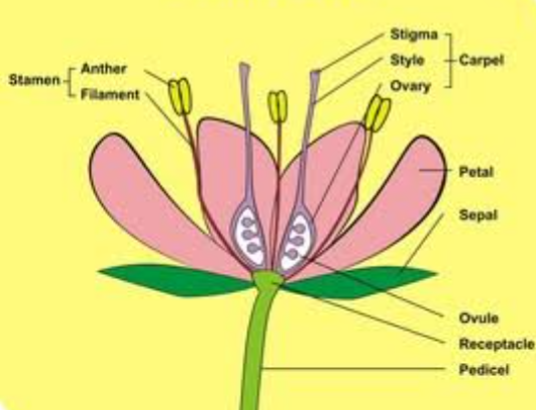
ASEXUAL OR VEGETATIVE PROPAGATION OF FRUITS
This is when the vegetative parts of the fruit plant is used as a propagating material apart from the seed. The vegetative parts include stem cutting, root cutting, leaf, single bud cutting, grafting and layering. For example, date, banana, and pineapple are propagated by use of offshoots or suckers. Grape, fig, olive, and blueberry are propagated from cuttings. Strawberry by stolon and runners.
METHODS OF VEGETATIVE PROPAGATION
budding, grafting and layering are the methods of vegetative propagation.
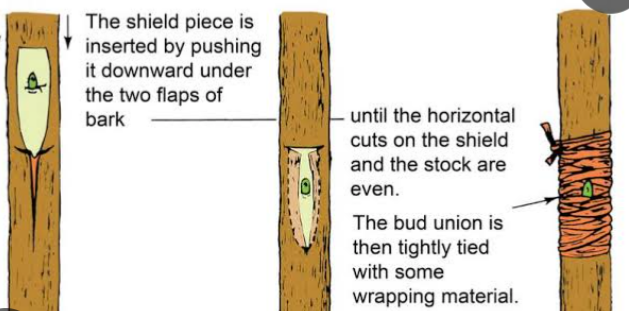
BUDDING: This is a technique of inserting a scion to the bark of the stock. The scion is carved from the shoot inform of a shield. The shield must be cut with small tongue of sapwood and cambium. And it must bears a bud on it. On the root stock, a T-shaped incision is made with its cambium exposed . Then, the bud shield is inverted between the sapwood and the bark so that the two cambium layers of the scion and the stock make a close contact. Bind the union firmly with a tape but leave the bud uncovered so that it is free to develop. After 10 to 14 days, the bud would have swollen and the leave stalk begins to develop. A week after, the tape should be removed.
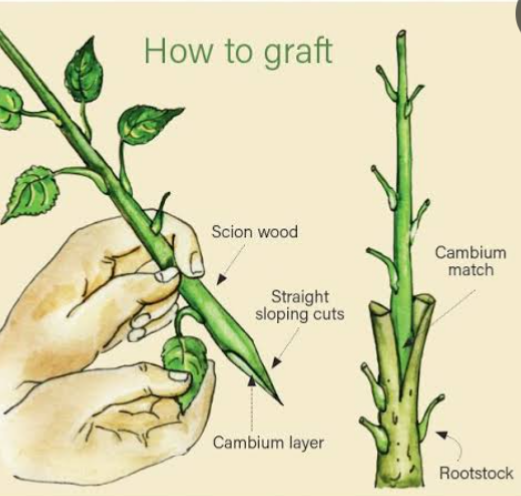
GRAFTING: This is a type of vegetative propagation in which a union is made between two separate woody stems. The upper stem is called the scion while the lower stem is called the root stock. There are different types of grafting. They include: cleft or wedge grafting, whip grafting, bud grafting, approach grafting.
RULES IN GRAFTING
a) Both the scion and the stock must be of the same species
b) The scion must taken from a tree possessing the desirable character/trait. For example, resistant to diseases, fruit sweetness, etc
c) The root stock must be developed from the seed with its vigorous root system of holding it to the soil.
HOW GRAFTING IS CARRIED OUT
The scion should be separated from the tree with the desired character. The top of the stock should be cut off smoothly along side any leaves developing on it . The scion should be placed on top of the rootstock and taped at the joint firmly.
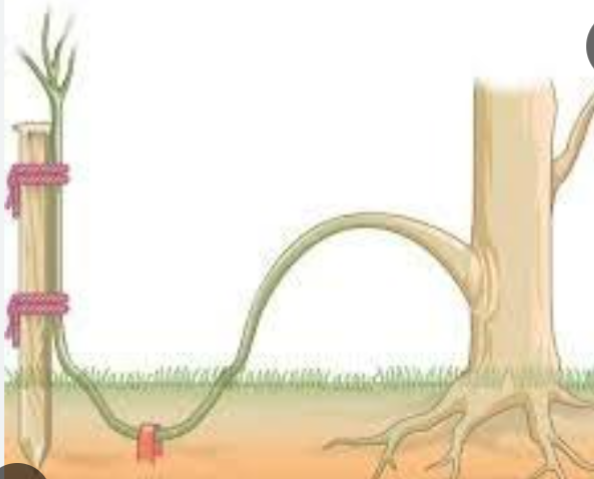
LAYERING: This is a vegetative propagation method in which the twigs or branches of the plant is made to make direct contact with the ground. The part of the branch in the soil develops roots and later detached from the mother plant. This can be carried out on fruits like cashew, mango, bread fruits, black raspberry etc. There are different types of layering. They include mound layering, areal layering etc.
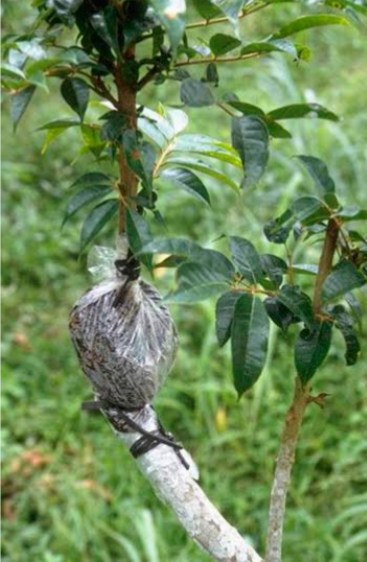
NEGATIVE EFFECTS OF NOT CONSUMING FRUITS
Chronic diseases such as cardiovascular diseases, blood pressure, hypercholesterolemia, osteoporosis, many cancers, chronic obstructive pulmonary diseases, respiratory problems as well as mental health can affect human being if they do not consume fruits.
TERMINOLOGIES USED IN FRUITS
DRY INDEHISCENT – they do not dehisce or split open. For examples Achenes, nuts, caryopsis, cypsela, and samara
DRY DEHISCENT -The pericarp has the ability to split (dehisce) For example, follicle, capsules, legumes, schizocarp
SUCCULENT FRUITS : They possess edible fleshy parts. For example: drupe, berry, pomes,
PERICARP (fruit wall) it is the entire outer layer of the ovary wall which ripens into an edible part of the fruit.
SCHIZOCARPS are dry fruits, though some appear to be fleshy. They originate from syncarpous ovaries but do not actually dehisce; rather, they split into segments with one or more seeds. For example, carrot, parsley, cumin.
FOLLICLE – follicles are formed from a single carpel, and opens by one suture
SYNCARPOUS (fused) fleshy fruit, a simple fruit, developing from a half-inferior ovary.
CYPSELA – an achene-like fruit derived from the individual florets in a capitulum: (dandelion).
ACHENE – most commonly seen in aggregate fruits
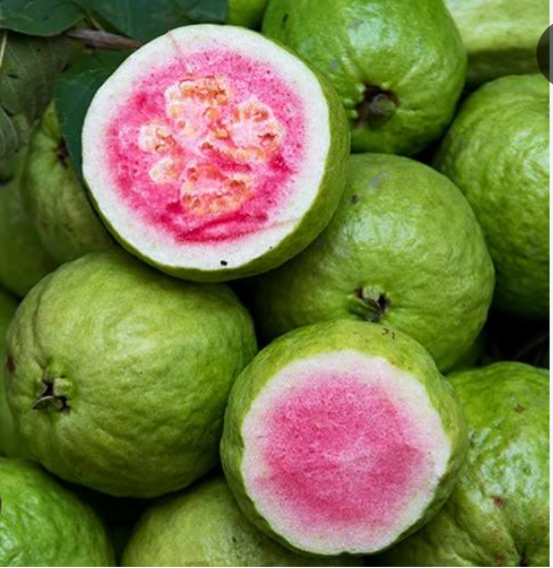
SOME COMMON FRUITS AND THEIR SCIENTIFIC NAMES
Cashew (Anacadium occidentale)
Cocoa (Theobroma cacao)
Pawpaw (Carica papaya)
Sweet orange (Citrus sinensis)
Grape fruit ( Citrus paradisi)
Lemon (Citrus lemon)
Tangerine (Citrus reticulata)
Banana (Musa sapientum)
Pineapple (Ananas comosus)
Guava (Psidium guajava)
Kola nut (Cola nitida)
